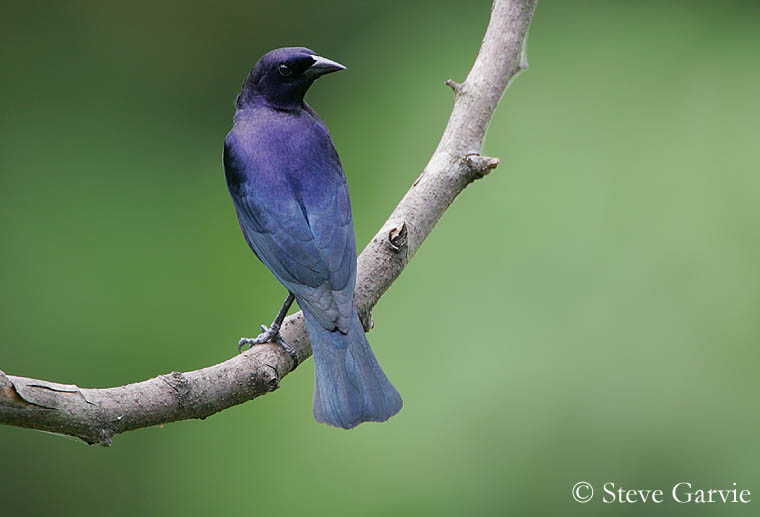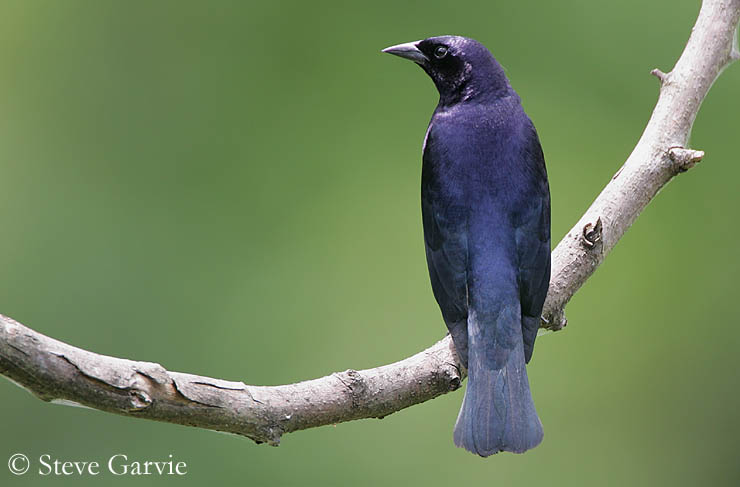
Shiny Cowbird
Molothrus bonariensis
Passeriforme Order - Icteridae Family
BIOMETRICS :
Length: 18cm ; Wingspan: 30 cm ; Weight: 31-40 g
LONGEVITE : up to 5 years
DESCRIPTION:
Shiny Cowbird male has glossy violet blue-black or purplish-black plumage. Wings and tail are glossy greenish-blue. Head and breast are more glossy and coloured than other parts of body.
Conical, pointed bill is blackish. Eyes are dark brown. Legs and feet are black.
Female has dull greyish-brown plumage, with paler underparts. We can see a slight bluish gloss on upperparts. She has pale indistinct eyebrow.
Juvenile resembles female Brown-headed Cowbird, which is grey-brown above and paler below, but juvenile Shiny Cowbird has darker colour, more prominent eyebrow and faint streaks on chest.
We can find seven subspecies, which differences include coloration of both sexes, wings and tail sizes, and bill size and shape.

VOICE: SOUNDS BY XENO-CANTO
Shiny Cowbird’s call is “chuck” used by both sexes. Birds give the same call when fighting, but harsher and more grating, rapidly repeated.
Song includes three to four low “purr”, followed by ascending series of “pe-tss-tseeee”. We can also hear a twitter song, including three short notes, followed by twitter of six to nine syllables.
Female most commonly utters chatters, rapid chattering slightly metallic. Male in flight gives flight-whistles, a plaintive whistle, usually preceded by “chuck” and by chatter.
HABITAT:
Shiny Cowbird frequents agricultural areas with patches of trees and shrubs, pastures, grasslands, open forests and clearings. This species colonizes deforested areas such as fields, gardens and plantations, but it also occurs in savannahs, scrub habitat in semiarid locations, and mangroves. In some parts of its range, it is found in suburban areas.
RANGE:
Shiny Cowbird is found in Southern Florida where it is uncommon. It is resident in Caribbean and most of parts of South America.
BEHAVIOUR:
Shiny Cowbird forages on the ground, walking and scratching ground with feet. It takes food from ground and from low vegetation, and jumps vertically or extends its neck for reaching higher food items. When feeding in trees, it hops and flutters from twig to twig, gleaning arthropods. It can also perform hover-fly-catching in stationary position for food from vertical surface. It forages alone or in flocks with other icterids.

Male Shiny Cowbird frequently chases other birds, and is aggressive towards other cowbirds and similar size species. Aggressions include “head-forwards threat”, and “bill-tilt display”, physical contacts breast to breast, and chasings. During chases, male gives songs and whistles.
Other kinds of displays are observed between males, used in sexual and aggressive contacts, also preening invitation where recipients may preen displaying bird. Female may use some of male’s displays towards other females.
During courtship displays, male sings while circling perched female repeatedly. Then, male lands close to female and performs bow displays, ruffling head and body feathers, arching wings and dropping tail, giving guttural sounds while shaking body. It also may bend the head while singing.
Shiny Cowbird is highly social, often living in flocks year-round. They feed and roost with other species. Shiny Cowbird is known for parasitizing hosts’ nests.
FLIGHT:
Shiny Cowbird has slightly undulating flight, but it can perform rapid swooping direct flight with rapid wing beats.
REPRODUCTION:
Shiny Cowbird is a brood parasite species. The nest is selected by female, and it is that of another species. Cowbird eggs and young are raised by hosts, and reflect characteristics of the host species. Usually, female cowbird removes one host egg before laying her own egg.
Many host species accept cowbird eggs, but other species can distinguish them, and as they eject cowbird eggs, or they abandon their nest.
Hosts may be smaller or larger birds than Shiny Cowbird, and they are chosen with two factors, abundance and quality.
Hosts selected are often nesting in cavities or in enclosed nests. When female cowbird finds nest, by active searching, she performs short noisy flights into nesting areas, in order to flush hosts from their nest.
Cowbird’ eggs are slightly glossy, white, pale grey, pale blue or pale buff, and marked with dark spots or blotches. Immaculate colour morph exists.
Incubation period may vary from 11 to 15 days, according to host species. Chicks are altricial, nearly naked at hatching with sparse tufts of pale grey down. Cowbird nestlings use “unusually aggressive and vigorous begging behaviour”. Young fledge about 12 to 15 days after hatching. Host adults care them for two weeks, sometimes more.

DIET:
Shiny Cowbird feeds mainly on insects and some seeds, including rice, and also eats spiders.
PROTECTION / THREATS / STATUS:
deforestation and changes for agriculture are associated to population increase with expansion of the range.
But Shiny Cowbird is a brood parasite, and its populations are under control, in order to protect parasitized host species.
In certain parts of its range, Shiny Cowbird is considered as a pest, due to its consumption of livestock foods. It may also act as vector of diseases and parasites for poultry populations.
Fr: Vacher luisant
All : Seidenkuhstärling
Esp : Vaquero Mirlo
Ital : Molotro splendente
Nd : Glanskoevogel
Photographs by Steve Garvie
His website :
RAINBIRDER Photo galleries
Text by Nicole Bouglouan
Sources:
FIELD GUIDE TO THE BIRDS OF NORTH AMERICA - National Geographic Society - ISBN: 0792274512
A GUIDE TO THE BIRDS OF MEXICO AND NORTHERN CENTRAL AMERICA by Steve N. G. Howell, Sophie Webb - Oxford University Press - ISBN: 0198540124
A GUIDE TO THE BIRDS OF COLOMBIA by Steven L. Hilty and William L. Brown
Princeton University Press – ISBN 069108372X
All About Birds (Cornell Lab of Ornithology)
What Bird-The ultimate Bird Guide (Mitchell Waite)
Wikipedia (Wikipedia, The Free Encyclopedia)
SORA Searchable Ornithological Research Archive (Blair O. Wolf)